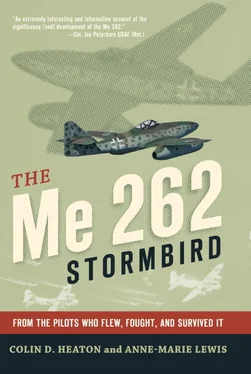Despite all the deserved praise heaped upon the Me 262, there were still “bugs” in the system. Even as late as November 5, 1943, Dr. Anselm Franz, working with the Jumo design, communicated with both Erhard Milch and Hermann Göring as they visited the plant at Dessau:
“The difficulties we still have involve individual components of the engine, and I would like to select only two from this group. One is the turbine. Recently we have had certain difficulties with the turbine wheel, with unexpected failures in the turbine blades due to vibration. The second component is the control system, and here I will touch on the problem of opening and closing the throttles, which was raised by the Reichsmarschall .
“I mentioned in Regensburg that we had things under control up to 8,000 meters. Beyond that we are still somewhat unsure. But we have already flown to over 11,000 meters. However, it cannot be guaranteed with certainty that we will have the problem at upper altitudes rectified by the time series production begins, so that the pilot will be able to open and close the throttles without worrying about a flame-out.” {8}
Oberfeldwebel Hermann Buchner, who flew the Me 262 with Kommando Nowotny and later JG-7, had his opinion on the Jumo engines and jet flying in the war: “I had success in the jet, no doubt. I shot down twelve confirmed victories with this aircraft, fighters and bombers. [But] many times I had to land a jet without engine power, due to a malfunction in the engines or even the throttle mechanism. The problems had not been worked out all the way. There was not any real thorough, peacetime research and development. They had this engine, it worked well enough, and they rushed it into production. Otherwise, the 262 would have been the perfect fighter.” {9}
Initially, the combustion chambers were made of mild (not tempered) steel and coated with a baked-on aluminum glaze to prevent them from oxidizing. However, when the engine was running, these combustion chambers slowly buckled out of shape. The turbine blades were made of a steel-based alloy that contained some nickel and chromium. That material was insufficiently resilient, however; when the engine was running, the centrifugal forces caused the blades to elongate, or “creep.” What was needed was much harder material that could withstand the intense heat and pressure.
The running life of preproduction Jumo 004s rarely reached more than ten hours. Throughout a flight, the pilot had to be very careful when advancing the throttle, which was vital to avoid an engine flameout or excessive overheating. At altitudes of above 13,000 feet, the engine became increasingly temperamental, where throttle movement was not advised. If a flameout occurred, the pilot had to shut off the fuel to the engine, since flooding could easily cause an engine fire, then descend to thicker, more oxygenated air before attempting a reignition. If the conditions were excellent, the engines could be restarted below 13,000 feet and at speeds between 250 and 300 miles per hour. Any higher altitude or faster speed made it virtually impossible, but flying below 250 miles per hour with a dead engine brought on new dangers—the pilot had better be on approach for a landing or prepared to jettison his canopy for a bailout under those circumstances. There are numerous examples in the loss records of German jets of all designs meeting their end in such ways. Due to these issues, the early version of the Jumo 004 had too many problems to allow mass production.
Ar 234 pilots found the aircraft a pleasure to fly overall, despite engine flameouts being a worrisome problem, the difficulty in escaping a damaged jet, and a variety of issues caused by inconsistent quality and grades of fuel, exacerbated by increasing fuel shortages. Pilots new to flying the jets often had great difficulty understanding the long takeoffs and high landing speeds, leading to a higher than normal accident rate. However, 8/ZG-76 managed to obtain a two-seat Me 262 jet trainer to familiarize new Ar 234 pilots, and following this adaptation, training accidents were greatly reduced. Interestingly, bomber pilots, as opposed to fighter pilots, had a much easier transition period with all jet versions.
The Jumo 004B-1 engines were ready for testing, and Me 262V7, coded as VI+AB, work number 130002, first flew with these engines on December 20, 1943, with Gerd Lindner behind the stick. This model was again different from its predecessors, since it incorporated an adjusted cockpit control mechanism to adjust the tail plane control, the very failure that had killed Wilhelm Ostertag. In addition, the new variant had a pressurized cockpit, a new and radical departure from existing versions of the Me 262, and a feature only incorporated in 1944 as standard equipment on the later Me 109K, Focke-Wulf 190D, and Ta 152 designs. {10}
This aircraft was finally destroyed on May 19, 1944, with the twenty-four-year-old test pilot Unteroffizier Hans Flachs killed in the process. As cited by Morgan, the official Messerschmitt flight record has the following comments about Flachs:
“ Uffz Flachs, born on 3 November 1919, was initially a pilot in a destroyer squadron, and had several victories to his credit. He had been awarded the Iron Cross First Class, and was a member of the Evaluation Command (Ekdo) 262. He did his conversion training on the Me 262 and was considered as trained. He was then transferred to the Messerschmitt AG. The Flight Section held the hope that Flachs was on the way to becoming a first class test pilot, and both in and out of the cockpit, he had created an excellent impression.” This report was posted on May 26, 1944. (See Table 3for the flight test record of this aircraft.)
On March 18, 1943, Me 262V8, VI+AC, flew using the same Jumo 004B-1 engines, and it was the first test-flown variant to be equipped with the complete Rheinmetall-Borsig 30mm quad-mounted cannons in the nose. This was to allow the test pilots to fly the aircraft under fully operational weight conditions. This became the first Me 262 to be delivered to Kommando Thierfelder on April 19, 1944; however, this aircraft was destroyed in a landing incident in October 1944. {11} (This aircraft is not reflected in the loss records located in Appendix 3: Recorded Me 262 Losses. Losses of training and research and development aircraft were not recorded within the same department and method as losses from operational units.)
Testing of the Me 262 was not conducted only to examine flight characteristics and weaponry. Me 262V9, VI+AD, work number 130004, was a test platform for both communications gear and electrically operated acoustic homing and detection devices. This was the version that would examine the aircraft’s capabilities of possibly being used in the role of the radar-guided night fighter variant. On October 1, 1944, this model was fitted with the new lower-profile streamlined “racing” canopy. The tail fin and rudder were also larger to provide greater control surface response, and the elevators were wider.
The test pilot was Karl Baur during January 1945, with both Baur and Lindner flying the machine at various times. The new improvements that had been incorporated paid dividends, as the high-dive-speed control issues had been resolved. The airflow over the canopy was reduced, thus allowing the pilot to maintain greater elevator and rudder control without the surfaces “freezing” and possibly causing a crash. These advances came far too late to make a great difference in the production of future jets, however, let alone alter the course of the air war.
TABLE 3:
ME 262V7 FLIGHT TESTS
| Flight No. |
1 |
| Date of Flight |
Dec. 16, 1943 |
| Flight Duration (minutes) |
Static |
| Pilot |
N/A |
| Airfield |
Augsburg |
| Flight No. |
2 |
| Date of Flight |
Dec. 20, 1943 |
| Flight Duration (minutes) |
5 |
| Pilot |
Lindner |
| Airfield |
Lechfeld |
| Flight No. |
3 |
| Date of Flight |
Dec. 21, 1943 |
| Flight Duration (minutes) |
19 |
| Pilot |
Lindner |
| Airfield |
Factory field |
| Flight No. |
4 |
| Date of Flight |
Jan. 3, 1945 |
| Flight Duration (minutes) |
Static |
| Pilot |
N/A |
| Airfield |
Factory field |
| Flight No. |
5 |
| Date of Flight |
Jan. 4, 1945 |
| Flight Duration (minutes) |
13 |
| Pilot |
Lindner |
| Airfield |
Factory field |
| Flight No. |
6 |
| Date of Flight |
Jan. 5, 1945 |
| Flight Duration (minutes) |
18 |
| Pilot |
Lindner |
| Airfield |
Factory field |
| Flight No. 7 |
| Date of Flight |
Jan. 5, 1944 |
| Flight Duration (minutes) |
24 (night) |
| Pilot |
Beauvais |
| Airfield |
Factory field |
| Flight No. |
8 |
| Date of Flight |
Jan. 9, 1945 |
| Flight Duration (minutes) |
24 |
| Pilot |
Lindner |
| Airfield |
Factory field |
| Flight No. |
9 |
| Date of Flight |
Jan. 13, 1944 |
| Flight Duration (minutes) |
8 (night) |
| Pilot |
Behrens |
| Airfield |
Factory field |
| Flight No. |
10 |
| Date of Flight |
Jan. 13, 1944 |
| Flight Duration (minutes) |
7 |
| Pilot |
Lindner |
| Airfield |
Factory field |
| Flight No. |
11 |
| Date of Flight |
Jan. 28, 1944 |
| Flight Duration (minutes) |
12 |
| Pilot |
Lindner |
| Airfield |
Factory field |
| Flight No. |
12 |
| Date of Flight |
Jan. 29, 1944 |
| Flight Duration (minutes) |
46 |
| Pilot |
Schmidt |
| Airfield |
Factory field |
| Flight No. |
13 |
| Date of Flight |
Jan. 30, 1944 |
| Flight Duration (minutes) |
51 |
| Pilot |
Schmidt |
| Airfield |
Factory field |
| Flight No. |
14 |
| Date of Flight |
Jan. 31, 1944 |
| Flight Duration (minutes) |
48 |
| Pilot |
Schmidt |
| Airfield |
Factory field |
| Flight No. |
15 |
| Date of Flight |
Jan. 31, 1944 |
| Flight Duration (minutes) |
17 (night) |
| Pilot |
Behrens |
| Airfield |
Factory field |
| Flight No. |
16 |
| Date of Flight |
Feb. 1, 1944 |
| Flight Duration (minutes) |
52 |
| Pilot |
Schmidt |
| Airfield |
Factory field |
| Flight No. |
17 |
| Date of Flight |
Feb. 1, 1944 |
| Flight Duration (minutes) |
46 |
| Pilot |
Schmidt |
| Airfield |
Factory field |
| Flight No. |
18 |
| Date of Flight |
Feb. 2, 1944 |
| Flight Duration (minutes) |
8 |
| Pilot |
Schmidt |
| Airfield |
Factory field |
| Flight No. |
19 |
| Date of Flight |
Apr. 2, 1944 |
| Flight Duration (minutes) |
Static |
| Pilot |
N/A |
| Airfield |
Factory field |
| Flight No. 20 |
| Date of Flight |
Apr. 11, 1945 |
| Flight Duration (minutes) |
18 |
| Pilot |
Tesch |
| Airfield |
Factory field |
| Flight No. 21 |
| Date of Flight |
Apr. 12, 1944 |
| Flight Duration (minutes) |
32 |
| Pilot |
Tesch |
| Airfield |
Factory field |
| Flight No. |
22 |
| Date of Flight |
Apr. 16, 1944 |
| Flight Duration (minutes) |
36 |
| Pilot |
Tesch |
| Airfield |
Factory field |
| Flight No. |
23 |
| Date of Flight |
Apr. 18, 1944 |
| Flight Duration (minutes) |
26 |
| Pilot |
Ruther |
| Airfield |
Factory field |
| Flight No. |
24 |
| Date of Flight |
Apr. 19, 1944 |
| Flight Duration (minutes) |
25 |
| Pilot |
Ruther |
| Airfield |
Factory field |
| Flight No. |
25 |
| Date of Flight |
Apr. 20, 1944 |
| Flight Duration (minutes) |
47 |
| Pilot |
Ruther |
| Airfield |
Factory field |
| Flight No. |
26 |
| Date of Flight |
Apr. 21, 1944 |
| Flight Duration (minutes) |
20 |
| Pilot |
Ruther |
| Airfield |
Factory field |
| Flight No. |
27 |
| Date of Flight |
Apr. 23, 1944 |
| Flight Duration (minutes) |
39 |
| Pilot |
Tesch |
| Airfield |
Factory field |
| Flight No. |
28 |
| Date of Flight |
Apr. 29, 1944 |
| Flight Duration (minutes) |
32 |
| Pilot |
Tesch |
| Airfield |
Factory field |
| Flight No. |
29 |
| Date of Flight |
May 6, 1944 |
| Flight Duration (minutes) |
Static |
| Pilot |
N/A |
| Airfield |
Factory field |
| Flight No. |
30 |
| Date of Flight |
May 8, 1944 |
| Flight Duration (minutes) |
25 |
| Pilot |
Tesch |
| Airfield |
Factory field |
| Flight No. |
31 |
| Date of Flight |
May 9, 1944 |
| Flight Duration (minutes) |
11 |
| Pilot |
Tesch |
| Airfield |
Factory field |
| Flight No. |
32 |
| Date of Flight |
May 9, 1944 |
| Flight Duration (minutes) |
37 |
| Pilot |
Tesch |
| Airfield |
Factory field |
| Flight No. |
33 |
| Date of Flight |
May 13, 1944 |
| Flight Duration (minutes) |
Static |
| Pilot |
N/A |
| Airfield |
Factory field |
| Flight |
No. 34 |
| Date of Flight |
May 14, 1944 |
| Flight Duration (minutes) |
27 |
| Pilot |
Tesch |
| Airfield |
Factory field |
| Flight No. |
35 |
| Date of Flight |
May 19, 1944 |
| Flight Duration (minutes) |
15 |
| Pilot |
Flachs |
| Airfield |
Factory field (last flight) |
Читать дальше













